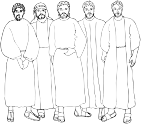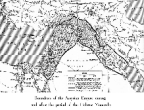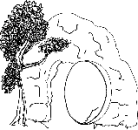New Testament Survey
Acts
LOOKING AHEAD TO . . .
Acts
Key Verse(s):
- 1:8
- 2:42-47
Key Chapter(s):
- Chapter 1
- Chapter 2
- Chapter 9
- Chapter 10
- Chapter 15
Key Word(s) or Concept(s)
- Holy Spirit
- Witness
Consider:
Who is the author?
How do you know this?
Who is the audience?
How do you know this?
Is there a key theme to the book?
How is Jesus presented?
Suggested Reading beyond the Key Chapter(s):
- Chapters 22
- Chapter 26
Acts
This book is the history of the early church. Luke picks up where his Gospel leaves off, adds a couple of details and moves on to show the persecution, expansion, and growth of the early church. Clearly the book is an incomplete history of the church. It is designed to show the outcome of Luke’s theme of salvation history, the effects of the Gospel message moving from Jerusalem to Samaria to the Gentiles, the “uttermost parts” of the earth (Acts 1:8). In the process, Luke focuses upon the actions of Peter and Paul.

But ye shall receive power, after that the Holy Ghost is come upon you: and ye shall be witnesses unto me both in Jerusalem, and in all Judaea, and in Samaria, and unto the uttermost part of the earth.
Acts 1:8

There were twelve apostles. Little is known about most of them, but tradition holds all of them preaching to some portion of the four corners of the world. All but John were reported to have been killed for their faith. Only the death of James, the son of Zebedee, is mentioned in Scripture. This event was fairly early in the life of the church and was further cause for the dispersion of the church, an event which spread the Gospel message. One set of traditions holds the following:
- James, the brother of John is killed by Herod - Acts 12:2.
- Paul is beheaded by Nero around A.D. 68.
- Peter is crucified upside down in Rome around A.D. 68/69.
- Andrew was crucified in Ephesus.
- Philip was stoned to death in Asia Minor.
- Thomas was killed by arrows in India.
- Bartholomew (Nathaniel) was skinned alive and beheaded, either in Egypt or India.
- Jude (Thaddeus), the son of James, was the youngest Apostle. He was shot full of arrows in Persia.
- James the less, was thrown from the Temple in Egypt. When the fall did not kill him, he was stoned and beheaded.
- Simon the Zealot was cut in half with a saw in Persia.
- Matthias died in Germany, being first stoned, then beheaded.
- Matthew was slain with a sword in Egypt or Ethiopia.
- Mark expired at Alexandria, after being cruelly dragged through the streets of that city.
- Luke was hanged upon an olive tree in the classic land of Greece.
- John is the only Apostle to die of natural causes in Ephesus. Tradition has him being boiled in oil and stoned in Rome and when this did not work, he was banned to the island of Patmos where he wrote Revelation.

And, of course, Judas Ischariot hanged himself (Matt 27:5). Luke records in Acts 1:18 that he feel headlong, bursting open his insides, most likely because he did a poor job of tying his own execution rope!
Theme and Purpose
As was indicated in the chapter on Luke, one way to understand the theme of this work is to attempt to guess at the question Theophilus may have asked which compelled Luke to write his accounts. In some form, this question must be "How did what is primarily a Gentile religion come from Judaism?” As we indicated in the chapter on Luke, the beloved physician attempts to demonstrate that Christianity is not anti-Semitic. Rather, just as Jesus says in John 4:22, “salvation is of the Jews.” The promise of salvation comes from the Old Testament Scriptures, the Scriptures of the Jews. This leads Luke into a study of salvation history and the manner in which the Jews rejected the Messiah causing Him to turn to the Gentiles.

In the process, Luke shows the story of the evangelism of the Good News, defends the ministry of Peter and Paul, shows the unity of the Church community, explains the delay of Christ’s Second Coming, argues against false religions, presents Jesus as the fulfillment of the Old Testament prophecies, and commits the entire story to writing so that future generations may have this knowledge. Along the way, he records and defends the history of the Christian movement from Jerusalem to Rome. What is interesting about this book is that none of the individual purposes are necessary for the understanding of this work. It is, in this sense, a true history of the church.
Authorship and Date
We have amply discussed in the chapter on Luke the arguments about Luke being the author of the Luke-Acts unit. We will not revisit these arguments.
A comment should be made concerning the date of Acts, for it sets the date of the Gospel as well. Some considerations were made in the chapter on the Gospel. It should be remembered that a portion of the argument on dating relates to one’s views on the date and usage of Mark. We would argue that while such an event is possible, and even likely, it is not a necessity. Luke alludes to a wide variety of witnesses and sources (Luke 1:1-4) that he used to write his account. These sources could well have included Mark and/or Matthew (although this is less likely). But, again, such use is not necessary.
It should also be obvious that Luke has much more first hand knowledge about the events of Acts, for he participated in many of them. Further, Paul is a prime actor in two-thirds of the book and Luke would have used the Apostle as his primary source. With Peter in Rome during part of the time Paul was there, Luke may well have had access to Peter’s recollections as well. He could also had in hand a complete or draft copy of Mark’s account also.
It is clear that the earliest date for completion of this book is the two year imprisonment of Paul recorded in Acts 28:30-31. This occurred somewhere around A.D. 60/61. Since the work is quoted by the second century church fathers, these two time frames fix the bookends for this work. If one accepts that Luke wrote both accounts, then it is unlikely it was written after the end of the first century A.D. Since Paul’s second and final imprisonment and death are not recorded, this would seem to place the writing closer to the time of the first imprisonment. Further, the persecution of the church which commenced under Nero is not mentioned. In the context of the work, this probably means that the persecution had not commenced. This persecution began in A.D. 64/65 and this would appear to fix the outside date for this account. Admittedly, this is an argument from silence and many will declare this is not a determinative argument, but it does fit with the balance of the evidence. The Romans may be generally uncaring, but the benefits given to Paul in Acts 28, with what amounts to a house arrest, do not fit with the presence of any persecution.
A further argument from silence is the lack of mention of the fall of Jerusalem and the destruction of the Temple when the Jews revolted in A.D. 66. The Temple was destroyed in A.D. 70, so, again, this would seem to help fix an outside date. Since the Temple and Jerusalem play such an important part in salvation history, it is highly unlikely these events would go unrecorded if they had occurred prior to the writing the account. The same is true of Peter’s and Paul’s deaths. If James’ death merited a place in Acts 12:2, how much more so would Peter’s and Paul’s?

A unique feature of the Acts is its lack of suggestion of the existence of any of the Pauline letters. Since it appears a collection of Paul’s letters existed as early as A.D. 70, it is unlikely that Luke wrote to preserve or reinstate the theology and applications contained in Paul’s letter. From a dating point of view, the lack of mention of this collection could suggest that the Acts is written before the accumulation of the letters. It is interesting, however, to speculate on why there is no mention of Paul’s writings. My own suggestion is that Luke knew of Paul’s works and made certain, from a sense of humility, that the history did not reflect the epistles of the Apostle.
These arguments, coupled with those presented in the chapter on Luke, strongly suggest a date that is prior to A.D. 64/65 for the writing of Acts.
Special Considerations
The title “The Acts of the Apostles” is found on almost all manuscripts and, so, dates from early in the life of the Church. On the other hand, a careful reading of the book clearly shows that the theme of the book is the work of God, or more particularly, God the Holy Spirit, in the lives of God’s early missionaries and the people they converted. Further, only Peter and Paul are prominent among the Apostles, so the title is not correct in any real fashion.
Acts reflects the building of the church in accordance with Christ’s statement of Matthew 16:18:
And I say also unto thee, That thou art Peter, and upon this rock I will build my church; and the gates of hell shall not prevail against it.
This is the institution of the New Covenant. To show this institution Peter quotes from Joel 2:28-31 in his first sermon recorded in Acts 2:16-21:

16 But this is that which was spoken by the prophet Joel; 17 And it shall come to pass in the last days, saith God, I will pour out of my Spirit upon all flesh: and your sons and your daughters shall prophesy, and your young men shall see visions, and your old men shall dream dreams: 18 And on my servants and on my handmaidens I will pour out in those days of my Spirit; and they shall prophesy: 19 And I will shew wonders in heaven above, and signs in the earth beneath; blood, and fire, and vapour of smoke: 20 The sun shall be turned into darkness, and the moon into blood, before that great and notable day of the Lord come: 21 And it shall come to pass, that whosoever shall call on the name of the Lord shall be saved.
The highlighted portion of the last verse shows Luke’s intent in recording salvation history. The Luke-Acts unit is designed to demonstrate that the name of the Lord is Jesus Christ! His name is the one to call upon under the New Covenant.
The book of Acts becomes the bridge between the Gospels and the rest of the New Testament. It’s outline is structured around Acts 1:8:

But ye shall receive power, after that the Holy Ghost is come upon you: and ye shall be witnesses unto me both in Jerusalem, and in all Judaea, and in Samaria, and unto the uttermost part of the earth.
From Jerusalem to Judea to Samaria and onto the uttermost reaches of the world, the Gospel message was carried upon the shoulders of God’s witnesses. Christ remained upon earth for 40 days after His Resurrection. His direction to His disciples was that they should wait until they had received the Power. This event occurred ten days later at Pentecost.

Pentecost means fifty in Greek. It is the second of the great Jewish feasts, recorded in Exodus 23:16 as “the feast of harvest,” and again in Exodus 34:22 as “the day of the firstfruits” (Num. 28:26). Leviticus. 23:15–19 and Numbers 28:27–29 describe the manner in which the feast is to be kept. This was the time of the free-will offering. This is the only feast where the free-will offering is prescribed.
Chapter 2 covers the events of Pentecost, the forming of the church. The outreach to Jerusalem is then recorded in Acts 2:5-8:3. The evangelizing of Judea and Samaria are covered in 8:4-12:25. From 13:1 to the end of the book, Acts is concerned with the spread of the Gospel to the uttermost parts of the earth. In the first portion of the book, the outreach to the Jews, Peter is the prime player. Thereafter, when the missionary work moves on primarily to the Gentiles, Paul becomes the center of focus. This shift occurs with Peter’s evangelism of Cornelius, a Gentile, in Acts 10.

Notice that some portions of the Christian faith place an overly great emphasis on the outward events of Pentecost. These denominations use the sign of tongues as proof of the indwelling power and presence of the Holy Spirit. A full study of this issue is beyond the scope of this survey. It should be noted, however, that the tongues spoken at Pentecost were different languages, not some uninterpretable noise. Further, many people are described as being saved and blessed in the New Testament without the presence of speaking in Tongues.
Acts records the first two important deaths in the church. Stephen, one of the original deacons of the church, becomes its first martyr (Acts 7:60). James, the brother of John, becomes the first Apostle to die. His death, the only death of an Apostle recorded in Scripture, is found in Acts 12:2.
The key player in the second half of the book is Saul of Tarsus, that is, Paul the Apostle. His conversion occurs in Acts 9. His testimony is given again in Acts 22 and 26. See the chapter following this one for more on Paul.
Notice that there is embedded in Acts a sort of on-going management report on the growth of the church.
- And the Lord added to the church daily such as should be saved - 2:47
- And the word of God increased; and the number of the disciples multiplied in Jerusalem greatly; and a great company of the priests were obedient to the faith - 6:7
- Then had the churches rest throughout all Judaea and Galilee and Samaria, and were edified; and walking in the fear of the Lord, and in the comfort of the Holy Ghost, were multiplied - 9:31
- But the word of God grew and multiplied - 12:24
- And so were the churches established in the faith, and increased in number daily - 16:5
- So mightily grew the word of God and prevailed - 19:20
- And Paul dwelt two whole years in his own hired house, and received all that came in unto him, Preaching the kingdom of God, and teaching those things which concern the Lord Jesus Christ, with all confidence, no man forbidding him - 28:30,31

Christ is portrayed in the Acts as the Resurrected Savior, the Redeemer of the world and the Messiah of the Jews. This is the cornerstone of all the sermons found in this book. The Holy Spirit provides the power, but it is the Resurrection which has opened the door for salvation. It is in the name of the risen Lord that people must believe to be reunited with God.

Neither is there salvation in any other: for there is none other name under heaven given among men, whereby we must be saved.
Acts 4:12To him give all the prophets witness, that through his name whosoever believeth in him shall receive remission of sins.
Acts 10:43And they said, Believe on the Lord Jesus Christ, and thou shalt be saved, and thy house.
Acts 16:31
Miracles are used in the Acts as a means of authenticating the messenger. The miracles are used as the springboard for the sermons to verify that the messenger brings a message of truth (2:15, 33; 3:12; 4:16; 28:1-10).
Outline
I Introduction and Instruction
- The Prologue 1:1-5
- The Ascension 1:6-11
- Preparation for the Witness 1:12-2:4
II Witness in Jerusalem
- Pentecost 2:4-47
- Peter and John 3:1-4:31
- The Apostles 4:32-5:42
- Stephen 6:1-8:3
III Witness in Judea and Samaria
- Philip 8:4-40
- Saul’s (Paul) Conversion 9:1-31
- Peter 9:32-11:18
- The Church 11:19-12:25
IV To the Uttermost Parts
- First Missionary Journey 13:1-14:28
- Jerusalem Council 15:1-35
- Second Missionary Journey 15:36-18:22
- Third Missionary Journey 18:23-21:16
- Paul’s Journey to Rome 21:17-28:31
![]()

